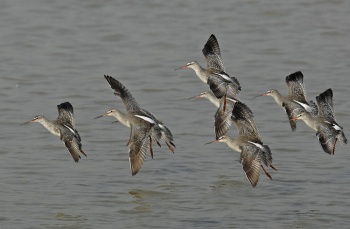- Tringa erythropus
Identification
29-32 cm (11½-12½ in)
Bill: Red lower mandible, with black tip; slightly de-curved
Red legs
White rump
Summer Adult
- Dark grey to black body
- Upperparts spotted white
Winter Adult
- Grey-brown above
- White below
- Grey chest
- Marked white supercilium
Juvenile similar to the winter adult but much darker. Irregular streaks on flanks
Similar Species
Can be told from winter-plumaged Common Redshank by the obvious white supercilium.
Distribution
They breed in Siberia and winter in Mediterranean Europe and Africa, China and South-east Asia.
Taxonomy
This is a monotypic species[1].
Habitat
They breed by pools, marshes and peatbogs. Winters on muddy estuaries.
Behaviour
Feeds in deeper water than Common, lunging at prey and sweeping the bill from side to side.
Flight

Photo © by Alok Tewari
Gurgaon Rural, Haryana, April-2017
Similar to Common Redshank but legs extend further beyond the tail.
Breeding
Generally monogamous. The clutch consists of 4 eggs, which are laid in a ground scrape.
Diet
The diet consists of fish, insect larvae, shrimps, amphibians and worms. Also terrestrial flying insects
Vocalisation
References
- Clements, J. F., T. S. Schulenberg, M. J. Iliff, T. A. Fredericks, J. A. Gerbracht, D. Lepage, S. M. Billerman, B. L. Sullivan, and C. L. Wood. 2022. The eBird/Clements checklist of Birds of the World: v2022. Downloaded from https://www.birds.cornell.edu/clementschecklist/download/
- Collins Pocket Guide to British Birds 1966
- Collins Field Guide 5th Edition
- Collins Bird Guide ISBN 0 00 219728 6
- Handbook of the Birds of the World Alive (retrieved Sept 2017)
Recommended Citation
- BirdForum Opus contributors. (2025) Spotted Redshank. In: BirdForum, the forum for wild birds and birding. Retrieved 12 March 2025 from https://www.birdforum.net/opus/Spotted_Redshank
External Links
GSearch checked for 2020 platform.1







